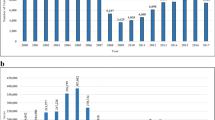Abstract
Research purpose: Empirically analyze the impact on land supplies structure of housing prices with the new first-tier cities as the research object. Research method: Collect the statistical data onto 15 new first-tier cities from 2009 to 2018 to construct a panel data model, and use stata15 measurement software to perform regression analysis on the impact on land supplied structure of housing prices. Research results: The land supply structure does have an impact on the sales price of commercial housing. The empirical results show that for every 1% increase in the proportion of residential land supplies, house prices will drop by 0.163%; for every 1% increase in the proportion of industrial land supplies, house prices will increase by 0.126%; For every 1% increase in the supplies of land for infrastructure, house prices will rise by 0.03%. Research conclusions: In order to stabilize urban housing prices and achieve healthy and high-quality development of the real estate market, it is necessary to scientifically and reasonably determining the land supply ratio, formulate land supplied plans according to the real estate market conditions in different regions, optimize the land supply structure, adapt measures to local conditions, implement policies in accordance with the city, and realize the rational allocation of land resources. In response to the current imbalance of land supply, without affecting the market operation, increase the proportion of residential land supply, reduce the proportion of infrastructure and industrial land supply, promote the balance of supply and demand, and ensure effective market supply. In addition, housing prices is affected by multiple factors. While adjusting the proportion of land supplied, other factors must also be controlled, working together in many ways, to effectively intervene and regulate the real estate market.
Access this chapter
Tax calculation will be finalised at checkout
Purchases are for personal use only
Similar content being viewed by others
References
Du, H.Y., Ma, Y.K., An, Y.B.: The impact of land policy on the relation between housing and land prices: evidence from China. Rev. Econ. Fin. 51(1), 19–27 (2011)
Hui, E., Leung, B.Y., Yu, K.: The impact of different land-supplying channels on the supply of housing. Land Use Policy 39(1), 244–253 (2014)
Fan, J S., Zhou, L., Yu, X F., Zhang, Y.Z.: Impact of land quota and land supply structure on China's housing prices: Quasi-natural experiment based on land quota policy adjustment. Land Use Policy 106(1) (2014)
Ding, C.R.: Policy and praxis of land acquisition in China. Land Use Policy 24(1), 1–13 (2007)
Grimes, A., Aitken, A.: Housing supply, land costs and price adjustment. Real Estate Econ. 38(2), 325–353 (2010)
Gu, G.W., Michael, L., Cheng, Y.P.: Housing supply and its relationships with land supply. Int. J. Hous. Mark. Anal. 8(3), 375–395 (2015)
Glaeser, E., Gyourko, J., Saiz, A.: Housing supply and housing bubbles. J. Urban Econ. 64(2), 198–217 (2008)
Hilber, C.A.L, Vermeulen,W.: The impact of supply constraints on house prices in England. Econ. J. 126, 358–405 (2016)
Chen M.C, Patel K.: House price dynamics and granger causality: An analysis of Taipei New dwelling market. J. Asian Real Estate Soc. l(1), 101–126 (1998)
叶贵, 朱科卫, 张继红.房价与地价的因果关系研究——基于重庆的实证检验. **土地科学30(6):62–70 (2016)
黄忠华, 虞晓芬, 杜雪君. 土地供应对住房价格影响的实证研究. 经济地理 4, 624–627 (2009)
单志鹏.在宏观调控中土地政策对房地产市场的影响效果研究. 吉林: 吉林大学(2013)
张诗琪. 我国城市土地供应与房地产市场关系研究——以35个大中城市为例. 云南: 云南财经大学(2009)
窦方.城市土地供应政策与房地产市场调控关系研究——以郑州市为例. 河南: 郑州大学(2009)
王岳龙, 邹秀清. 土地出让: 以地生财还是招商引资——基于居住—工业用地价格剪刀差的视角[J].经济评论5, 68-82 (2016)
Author information
Authors and Affiliations
Corresponding author
Editor information
Editors and Affiliations
Rights and permissions
Copyright information
© 2022 The Author(s), under exclusive license to Springer Nature Singapore Pte Ltd.
About this paper
Cite this paper
He, W., Song, B. (2022). Research on the Impact of Land Supply Structure on House Prices——Taking the New First-Tier Cities as an Example. In: Guo, H., Fang, D., Lu, W., Peng, Y. (eds) Proceedings of the 26th International Symposium on Advancement of Construction Management and Real Estate. CRIOCM 2021. Lecture Notes in Operations Research. Springer, Singapore. https://doi.org/10.1007/978-981-19-5256-2_53
Download citation
DOI: https://doi.org/10.1007/978-981-19-5256-2_53
Published:
Publisher Name: Springer, Singapore
Print ISBN: 978-981-19-5255-5
Online ISBN: 978-981-19-5256-2
eBook Packages: Business and ManagementBusiness and Management (R0)




